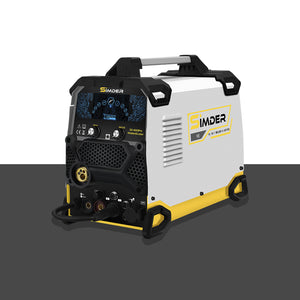3 productos
TIG Welders - TIG Welding and GTAW Welding Machines|SSimder Welder
SIMDER TIG welders offer the flexibility to tackle projects in any position, be it flat, horizontal, vertical, or even overhead. This makes them ideal for tight spaces or working within roll cages. Their machines handle a wide range of materials, including steel, stainless steel, nickel alloys, copper, brass. This versatility, coupled with their user-friendly design, makes SIMDER TIG welders a great choice for both beginners and experienced welders.
Most Popular Types of TIG Welder
TIG welding, or GTAW (Gas Tungsten Arc Welding), boasts a variety of approaches for tackling different welding projects. Let's explore some popular techniques:
DC TIG Welding:
This method utilizes a steady direct current (DC) to create a stable arc. It's ideal for achieving precise and controlled welds on materials like steel.
Pulse TIG Welding:
Unlike DC TIG, Pulse TIG uses a pulsating current that alternates between high and low peaks. This allows for faster welding speeds while maintaining excellent control over the heat input to the workpiece. It shines when working with thin sheets of stainless steel or carbon steel.
Fusion Welding:
This technique eliminates the need for filler metal. Instead, the intense heat from the TIG arc melts the edges of the joining pieces together, creating a fused joint.
TIG Welding with Filler Wire:
Many TIG applications require adding filler metal to the weld pool. This provides additional material for building up weld strength and creating a strong, reinforced joint.
AC TIG Welding:
This method employs an alternating current (AC) that breaks up the oxide layer that forms on certain metals like aluminum and magnesium. This allows for cleaner and more successful welding of these non-ferrous materials.
TIG's Versatility Across Industries:
TIG welding reigns supreme in its ability to handle a wider range of metals compared to other welding processes. This unmatched versatility makes it a go-to technique across numerous industries. In the high-stakes world of aerospace, TIG welding plays a critical role in constructing spacecraft and airplanes, ensuring the strength and reliability of these marvels of flight.
The automotive industry also leverages TIG welding's strengths. When it comes to car fenders, TIG welding is the clear champion. This is thanks to its anti-corrosive properties, which are essential for protecting these exposed components from the elements and ensuring a long service life.
Faqs
Frequently Asked Questions
Is the product compatible with UK power systems?
Yes, our welding machines are designed to support UK voltage (110V/220V) and comply with UK standards.
Do you offer free shipping for orders in the UK?
Yes, we provide free shipping for all orders within the UK. Delivery usually takes 3–5 business days.
Do you offer warranty support in the UK?
Yes, all products purchased in the UK come with a 3-year warranty. UK-based customer service is available for support.
Is the product compatible with UK power systems?
Yes, our welding machines are designed to support UK voltage (110V/220V) and comply with UK standards.
Do you offer free shipping for orders in the UK?
Yes, we provide free shipping for all orders within the UK. Delivery usually takes 3–5 business days.
Do you offer warranty support in the UK?
Yes, all products purchased in the UK come with a 3-year warranty. UK-based customer service is available for support.
What is a TIG welder used for?
TIG welding boasts incredible versatility, tackling a broad spectrum of metals. From the everyday like steel, stainless steel, and aluminum to specialized materials like chromoly, nickel alloys, magnesium, copper, brass, bronze, and even gold, TIG welders can handle it all. This translates to a wide range of applications. TIG welding's adaptability makes it a valuable tool for both everyday repairs and creative projects.
What is better MIG or TIG welding?
While TIG welding boasts superior weld strength and aesthetics in the hands of a skilled operator, its learning curve can be steeper. For less experienced welders, MIG welding might offer a more achievable path to quality welds. Additionally, MIG excels in speed, allowing for quicker completion of long weld runs.
Why is TIG better than stick welding?
TIG welding reigns supreme in versatility. It tackles a wider range of metals compared to other methods like MIG, flux core, or stick welding. This unmatched adaptability translates to cleaner, stronger, and higher-quality welds. TIG's ability to handle a variety of materials makes it a true powerhouse in the welding world.
Is TIG welding easier than stick?
While TIG welding offers superior control and weld quality, it comes with a steeper learning curve. This translates to slower welding speeds and potentially higher project costs due to longer lead times. In contrast, stick welding offers a more beginner-friendly approach with lower initial investment. Its versatility allows you to weld a wide range of metal alloys, making it a popular choice for quick and cost-effective projects.
Is a TIG welder AC or DC?
TIG welding uses direct current (DC) for mild steel and stainless steel, while alternating current (AC) is used for aluminum.






